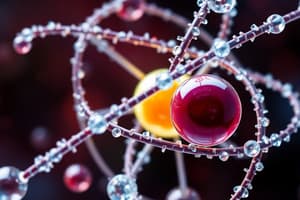Podcast
Questions and Answers
What is the primary reason the nucleus of an atom is positively charged?
What is the primary reason the nucleus of an atom is positively charged?
- It is located outside the atom
- It contains negatively charged electrons
- It contains positively charged protons (correct)
- It contains only neutrons
Which of the following statements is true regarding the atomic number?
Which of the following statements is true regarding the atomic number?
- The atomic number indicates the number of protons in the nucleus. (correct)
- The atomic number is represented by the letter A.
- The atomic number indicates the number of neutrons in the nucleus.
- The atomic number determines the mass number of an atom.
What does the mass number of an atom represent?
What does the mass number of an atom represent?
- The total number of nucleons in the nucleus (correct)
- The number of protons only
- The number of positively charged particles only
- The sum of the electrons and neutrons
What term is used to describe the region surrounding the nucleus where electrons are found?
What term is used to describe the region surrounding the nucleus where electrons are found?
Why is nearly all of an atom's mass concentrated in the nucleus?
Why is nearly all of an atom's mass concentrated in the nucleus?
Which of the following accurately describes nucleons?
Which of the following accurately describes nucleons?
What is the effect of the motion of electrons in an atom?
What is the effect of the motion of electrons in an atom?
What charge does the electron cloud possess?
What charge does the electron cloud possess?
Which symbol represents the atomic number of an atom?
Which symbol represents the atomic number of an atom?
What does the mass number indicate in an atom?
What does the mass number indicate in an atom?
Flashcards are hidden until you start studying
Study Notes
Structure of an Atom
- Subatomic particles are arranged systematically within an atom, not randomly.
- The nucleus is a small, dense, positively charged core found at the center of an atom.
- Nuclei contain protons (positively charged particles) and neutrons (neutral particles).
- Over 99.9% of an atom's mass is concentrated in the nucleus, making it extremely dense.
Nucleus Characteristics
- The nucleus is always positively charged due to the presence of protons.
- The small volume of the nucleus combined with its high mass results in significant density.
Extranuclear Region
- The outer region of the atom houses electrons, which move rapidly around the nucleus.
- This region accounts for most of the atom's volume, termed the electron cloud.
- Electrons are attracted to the nucleus by the electrostatic forces between oppositely charged particles.
Electron Cloud
- The rapid motion of electrons defines the atom's size, analogous to a fan blade generating volume.
- The electron cloud is negatively charged, reflecting the presence of electrons.
Nucleons
- Nucleons are subatomic particles found within the nucleus, specifically protons and neutrons.
- The nucleus can be viewed as a collection of nucleons.
Atomic Number
- Atomic number (Z) represents the total number of protons in an atom's nucleus.
- Since atoms are electrically neutral, the atomic number also indicates the number of electrons.
Mass Number
- Mass number (A) is the sum of protons and neutrons in the nucleus.
- The mass number accounts for nearly all of an atom's mass, as electrons contribute negligibly.
Chemical Notation
- In complete chemical symbol notation, the atomic number (Z) is written as a subscript before the chemical symbol.
- The mass number (A) appears as a superscript before the chemical symbol.
Studying That Suits You
Use AI to generate personalized quizzes and flashcards to suit your learning preferences.




